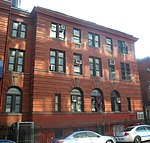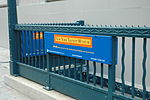Gage and Tollner
Commercial buildings completed in 1875Commercial buildings on the National Register of Historic Places in New York CityDowntown BrooklynItalianate architecture in New York CityNational Register of Historic Places in Brooklyn ... and 8 more
New York City Designated Landmarks in BrooklynNew York City interior landmarksRestaurants disestablished in 2004Restaurants established in 1879Restaurants in BrooklynRestaurants on the National Register of Historic PlacesSteakhouses in the United StatesUse mdy dates from April 2021

Gage and Tollner is a restaurant on 372 Fulton Street in the Downtown Brooklyn neighborhood of New York City. It had been in business since 1879 and in the same location since 1892 until it closed on February 14, 2004. The restaurant reopened in April 2021. The building, originally a residence, has been in existence since 1875. It is listed on the National Register of Historic Places and is a New York City designated landmark.
Excerpt from the Wikipedia article Gage and Tollner (License: CC BY-SA 3.0, Authors, Images).Gage and Tollner
Livingston Street, New York Brooklyn
Geographical coordinates (GPS) Address Nearby Places Show on map
Geographical coordinates (GPS)
| Latitude | Longitude |
|---|---|
| N 40.691111111111 ° | E -73.988055555556 ° |
Address
New York City Civil Court
Livingston Street 141
11201 New York, Brooklyn
New York, United States
Open on Google Maps









